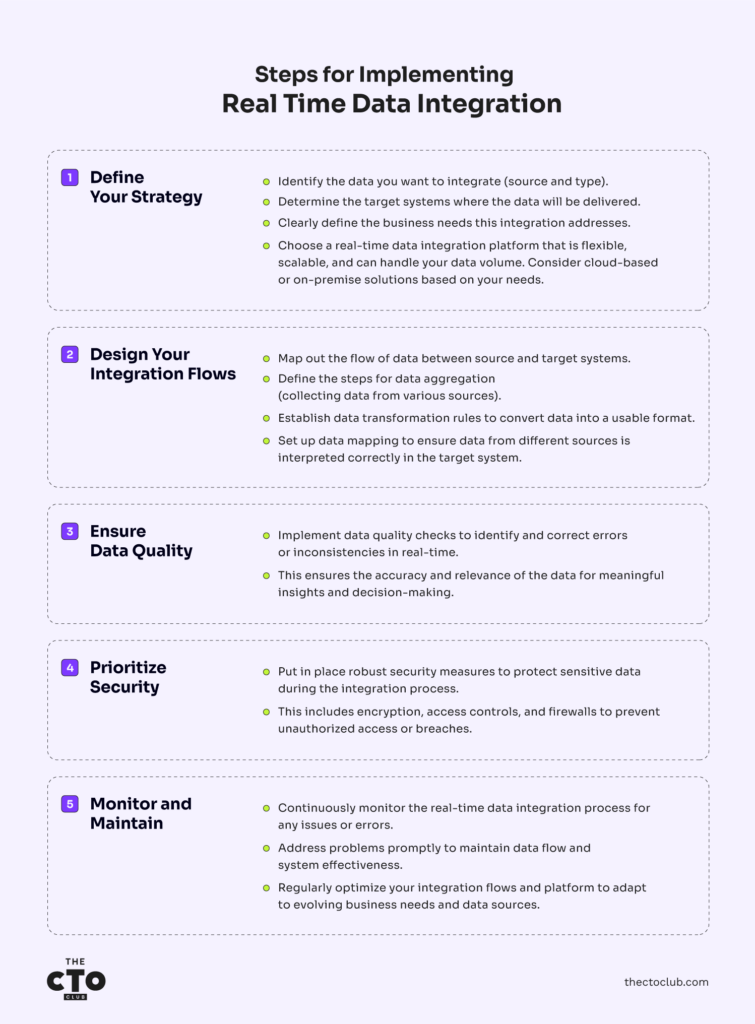Businesses are drowning in information. What if you could access and analyze data instantly, making smarter choices faster than ever before? That's the power of real time data integration – an approach that continuously combines data from various sources, transforming it into a unified format and delivering it instantly for immediate use. It enables businesses to leverage the latest information for informed, up-to-the-minute decisions.
This article examines this game-changing technology, explaining how it works, its benefits for businesses of all sizes, and the data integration tools you need to implement it successfully. You'll learn how real time data integration can streamline operations, improve decision-making, and give you a crucial edge over the competition.
-

Adverity
Visit WebsiteThis is an aggregated rating for this tool including ratings from Crozdesk users and ratings from other sites.4.5 -

Ketch
Visit WebsiteThis is an aggregated rating for this tool including ratings from Crozdesk users and ratings from other sites.4.5 -

Cleo Integration Cloud
Visit WebsiteThis is an aggregated rating for this tool including ratings from Crozdesk users and ratings from other sites.4.3
What is Real Time Data Integration?
Real-time data integration for small businesses and enterprises is a technologically advanced method for extracting information from different sources, transforming it into a unified format, and instantly delivering it to the necessary destinations. This process takes place in real time, making the data immediately available for use upon collection. As a result, it enables businesses to make effective and timely decisions based on up-to-date and accurate data.
Implementing real-time data integration can redefine a business's decision-making process. This approach is more than data transfer—it maintains the consistency of the data within the information system. As organizations grapple with high-speed data proliferation, they need tools with the capacity to facilitate real-time data integration. Thus, the right IT software infrastructure and cybersecurity tools become foundational components of ensuring the success of real-time data integration processes.
Why is Real Time Data Integration Important?
Real-time data integration is vital because it allows companies to access, analyze, and use relevant data immediately as it is generated. This ability to tap into live data holds various benefits. For instance, it provides an up-to-date and holistic view of business operations, which allows for agile decision-making processes.
It also improves operational efficiency; businesses can respond immediately to changes in trends or market conditions, which may give them a leg up over their competition.
Security is a significant concern in IT operations, and real-time data integration can play a pivotal role. Data breaches or system incidents can be instantly detected, allowing for immediate response and reducing potential damage. Also, with continually updated data, companies can seamlessly comply with regulatory changes and avoid sanctions.
Finally, real time data integration improves the accuracy and reliability of data, ensuring enterprises can trust the data for planning, forecasting, and critical decision-making processes. Thus, appreciating the importance of real-time data integration is key to business agility, compliance, and overall success.
Technology and Tools for Real Time Data Integration
Real-time data integration requires the right blend of technologies and tools to effectively collect, transform, and distribute data across disparate systems. Key in this process is Data Integration Tools like the following:
- Apache Kafka: an open source platform that handles real-time data feeds with high-throughput and fault-tolerance capability. It is a powerful tool for ingesting and buffering data before it reaches its destination.
- AWS Glue: A managed service by Amazon Web Services that simplifies real-time data integration by providing a visual interface for building data extraction, transformation, and loading ETL workflows.
- Google Cloud Dataflow: A unified programming model for batch and real-time data processing on Google Cloud Platform. It allows for building scalable data pipelines that can handle diverse data formats and sources.
Need More Info?
Pricing upon request
Free plan available
These tools are excellent for extracting data from numerous sources, transforming it into a usable format, and then loading it into a target database or data warehouse.
In addition, API (Application Programming Interface) tools can seamlessly connect different software and applications, allowing them to communicate effectively and thereby facilitating real-time data exchange.
Cybersecurity tools, on the other hand, play a vital role in ensuring the secure transfer of data; these may include encryption software, antivirus programs, and firewalls.
Furthermore, ETL (Extract, Transform, Load) tools are pivotal for the transformation and loading of real-time data.
All of these, combined with cloud-based infrastructure solutions that offer scalability and reliability like Microsoft Azure and Amazon Web Services (AWS), are instrumental in achieving effective real-time data integration.
Strategies and Steps for Implementation
Successful implementation begins with a well-thought-out strategy. It is crucial to identify the kind and source of data to be integrated, the target systems, and the specific business needs it addresses. Choosing the right integration platform is also a key consideration, factoring in aspects like flexibility, scalability, and speed of the software to process large volumes of data in real time.

The Superpower for Smarter Business Decisions
Real-time data integration plays a pivotal role in empowering companies to make timely, informed decisions. This process allows businesses to amalgamate data from various sources into a unified, real time view.
It takes information scattered across different systems (like sales figures, website traffic, and social media buzz) and merges it all into one constantly updated stream.
This gives you a complete picture of what's happening right now. With this real time intel, you can:
- Make decisions faster and with more confidence: No more waiting for reports! You can see trends and changes as they unfold, allowing you to react quickly and adjust strategies on the fly.
- Predict what's coming next: Real time data can help you identify patterns and forecast future trends. This lets you anticipate customer needs and stay ahead of the curve.
- Boost your agility: Tracking changes in real time allows you to be more responsive. See a dip in sales? You can investigate and fix the problem right away.
- Work together better: Everyone in your company can access the same up-to-date data, fostering collaboration and a culture of data-driven decision-making.
Think of it as having a central nervous system for your business. Real time data integration connects everything, giving you a pulse on your operations. Combined with the rise of cloud-based tools and strong cybersecurity, it's a powerful recipe for success.
Best Cybersecurity Software
Addressing Challenges
Managing real time data integration can present several challenges. These can range from ensuring accurate and timely data and system compatibility issues to managing resources efficiently.
- Data accuracy and timeliness are critical as decision-making is dependent on real-time data analysis. Minor errors could result in significant problems, and delays in data integration may result in missed opportunities or flawed decision-making processes.
- Ensuring system compatibility. Given the diversity of systems and data formats, integrating data in real-time from multiple sources can be technically demanding. This requires state-of-the-art tools and robust IT systems to handle the complexity of such tasks.
- Manage the resources effectively to achieve real-time data integration. This involves regularly reviewing and optimizing the infrastructure, enhancing the algorithms for data processing, and training the personnel regularly on innovative data management practices.
- Security of the data during integration is of the utmost importance and sufficient cybersecurity measures should be put in place. Overcoming these challenges would be crucial in ensuring successful real-time data integration.
Successful Real Time Data Integration
One notable example of successful real-time data integration is seen in Coca-Cola Japan's implementation. They leveraged a mobile app called "Coke ON" to integrate customer data in real time. The app might incentivize purchases through features like digital coupons or reward points, all tracked within the app. This real-time data collection allows Coca-Cola to understand customer behavior and preferences. By analyzing purchase patterns, they can tailor promotions and marketing strategies for maximum effectiveness.
Another successful example is Zyme, a global channel data solution provider. The company faced difficulties as its data was scattered across various systems, leading to inconsistent data and communication failures. By implementing real time data integration, Zyme successfully consolidated its data, thereby simplifying its data management process.
The real time integration also facilitated instantaneous data analysis, helping Zyme gain better insights into its customer behaviors and market trends. These insights empowered them to make data-driven decisions, optimize their marketing initiatives, and consequently accelerate their business growth.
Future Forecast
As we move forward in the digital era, real time data integration will continue to evolve. Technological advancements, improved software tools, and increased connectivity will pave the way for more efficient and effective data integration processes.
We expect to see a rise in the integration of Artificial Intelligence and Machine Learning techniques in this domain. These technologies will learn, predict, and automate data coordination, enhancing overall data quality and decision-making in real time.
As data-centric technologies become more sophisticated, the security aspects will also significantly evolve.
The importance of real time data integration will only intensify as the world becomes more data-reliant. It will become an essential tool for businesses of all sizes, across all sectors, to remain competitive and innovative, facilitating an instant, 360-degree view of operations.
Subscribe to The CTO Club’s Newsletter for more data integration insights.









